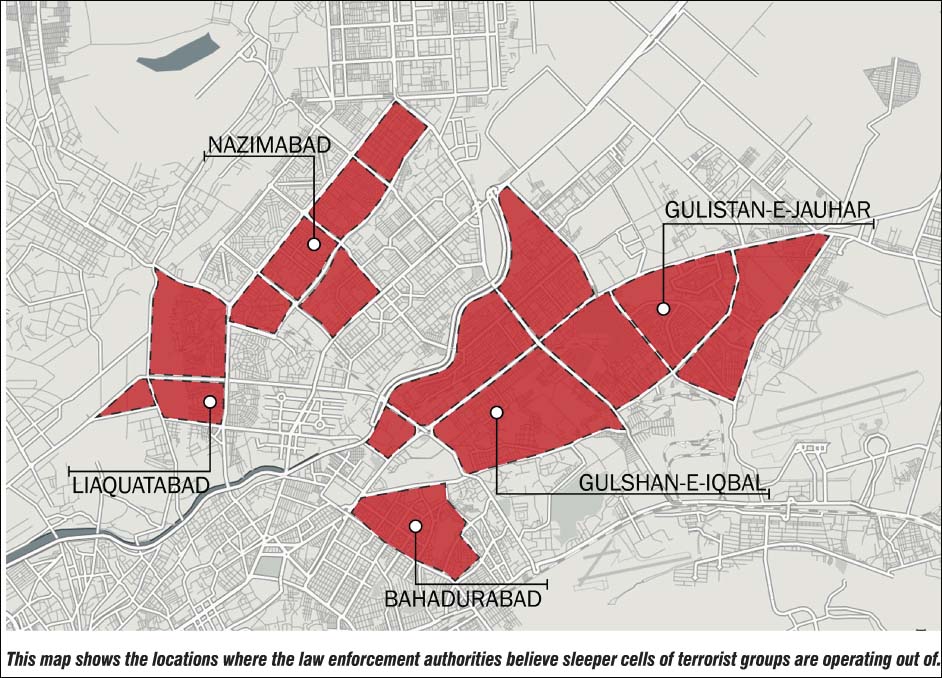The News investigation finds law enforcers are having a hard time locating cells since terrorists have blended in with ordinary citizens
An investigation by The News into the killing of three Karachi police officials in the Dhoraji and Manghopir localities has revealed that terrorists’ sleeper cells may have shifted to the centre of the city.
The probe found that the investigators are finding it difficult to locate the sleeper cells because the terrorists have blended in with ordinary citizens in populated areas of the city’s centre.
On May 20, head constable Raja Younus and Assistant Sub-Inspector Iftikhar were killed and constable Shahenshah injured when their police mobile van was attacked in Dhoraji, while on April 11, police intelligence officer Fareed Khan was gunned down inside a TV shop in Manghopir.
The investigation also revealed that the ongoing Karachi operation has wiped out only the terrorists’ networks across the city, but they are still operating their sleeper cells. The recent attacks on police officials in Dhoraji and Manghopir are stark reminders of their presence in the metropolis.
“The investigation of recent terrorist incidents has established the presence of sleeper cells of all terrorist organisations in the central part of the city,” Karachi police chief Addl IGP Mushtaq Mehar told The News.
“The probe also revealed that the terrorist organisations have shifted their sleeper cells from the outskirts of the city to the centre of the metropolis.” Mehar said there were reports that the sleeper cells were being operated out of Gulistan-e-Jauhar, Gulshan-e-Iqbal, Bahadurabad, Liaquatabad and Nazimabad.
He said the investigation into the killing of two police officials in Dhoraji had so far established that a sleeper cell was operating out of the locality where the incident had taken place.
He added that the investigators were trying to neutralise the cells, but they were facing problems in tracing their whereabouts because they had blended in with ordinary citizens.
Counter Terrorism Department (CTD) Sindh chief Addl IGP Sanaullah Abbasi corroborated the Karachi police chief’s claim, and said the CTD had identified and neutralised the sleeper cells operating out of the West, South and Central districts, but the department was having trouble finding the cells operating out of District East.
Abbasi said lack of expertise and technology at the forensic division had made it difficult to identify the groups behind attacks on policemen of the city. “Many arrested terrorists confessed to killing cops, but when we produce them in court, they retract their statements.”
He added: “The only way left to ensure conviction of the arrested terrorists is to present forensic evidence in court, but slow pace of work of the laboratories delay the convictions.”
However, Raja Umer Khattab, chief of the CTD’s Transnational Terrorism Intelligence Group, said terrorists could run their sleeper cells out of any part of the city.
“The important thing is that the cells are present in the city and are carrying out their activities. Sometimes the sleeper cells commit target killings to mark their presence in the metropolis.”
Khattab cited the example of a retired Pakistan Army colonel’s murder, explaining that the investigators could find nothing in the case, not even the motive.
Sharing the details of the attack on the intelligence officer, SSP (West) Nasir Aftab said it was an act of terrorism carried out by a sleeper cell.
Aftab said the investigators were monitoring the activities of some members of the cell, and vowed that the people responsible for the attack would be brought to book soon.
He also said it was difficult to locate the sleeper cells. “Some of the terrorists are working as masons while others are engaged in other temporary businesses, waiting for the right time to announce their return.”
CTD’s Khattab said the modus operandi in the May 20 attack suggested the involvement of a sleeper cell of an emerging global terrorist network. “There’s enough evidence to suggest that the cell is run by the Islamic State (or Daesh).”
He said the IS had carried out its first act of terrorism in the same vicinity where the two cops were killed. On March 4, 2015, a hand grenade was hurled at a shop of a Bohra trader in the Dhoraji locality. The explosion left a boy dead. The attackers had left behind a handbill announcing Daesh’s arrival in the country.
Khattab said that shooting the policemen in the heads on May 20 indicated that the sleeper cell involved in the attack belonged to Daesh. “We only have to consider the previous attacks of the group for that. The fact suggests that the attackers were highly trained.”

However, Addl IGP Abbasi said terrorists switched loyalties from time to time. “We can’t say for sure if Daesh is behind the May 20 attack, but there are possibilities that terrorists from other organisations who may have joined the IS are behind the incident.”
Speaking about the situation of terrorism across the province, he said the Sindh police had no database of terrorists. “The police have no information about the people who went to Afghanistan, Iran, Syria and Iraq.”
He added that foreign forces were funding terrorism across Pakistan. “Terrorists are infiltrating in the country from Afghanistan, Iran, Syria and Iraq. When we investigated the arrested terrorists, they disclosed they had been trained in these countries.”
Abbasi said the Sindh police could not visit conflict zones such as Afghanistan to collect details of Pakistanis hiding there. “It is the responsibility of intelligence agencies to gather data of militants returning to Pakistan after being trained in these countries.”
The picture shows a pharmacy. — AFP/FileThe Karachi administration has launched a campaign to check the expiry dates...
In this still, Karachi Mayor Barrister Murtaza Wahab addresses an event on April 25, 2024. — Facebook/Barrister...
In this still, Sindh Inspector General of Police Ghulam Nabi Memon chairs a meeting at the Central Police Office on...
Representational image shows police tape. — AFP/FileAn elderly man who ran a general store was shot and killed in...
A handcuffed suspect stands behind the bars with a policeman standing outside the jail in this undated image. —...
In this still, Sindh Chief Minister Syed Murad Ali Shah meets federal energy minister Owais Ahmad Khan Laghari in...







